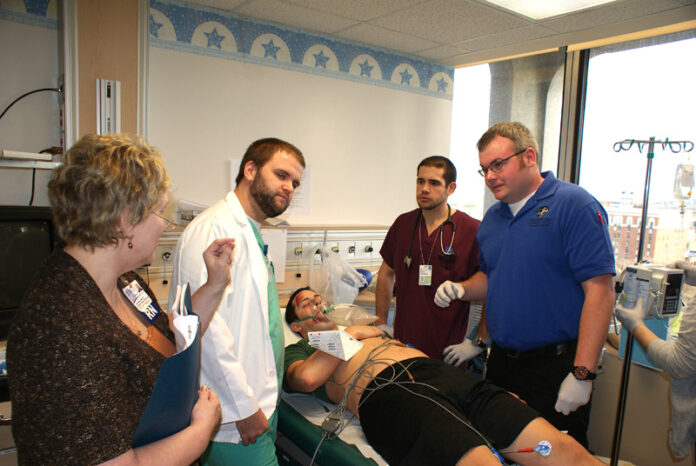
by Gene Marrano
There’s mass mayhem at the Jefferson College of Health Sciences as a major tornado has struck downtown Roanoke. Lots of trauma, people screaming, a woman giving birth, and even several deaths. It all took place last Friday morning and if you didn’t hear or read about it there’s a good reason: it was a simulation, the fourth annual “Interprofessional Simulation Activity,” which allowed students in JCHS programs, mostly seniors, to interact with others in a variety of academic disciplines.
Students from the nursing, physician assistant, respiratory therapy, health psychology, laboratory sciences and emergency services were among the departments that took part. Some were meeting for the first time ever and used the occasion to learn more about working together should a real emergency occur.
“Patients” in 9th floor labs were made up with realistic-looking wounds and scars; dummies sitting on tables nearby were employed when tubes, for example, had to be inserted down someone’s throat. Faculty members at Carilion Clinic-owned JCHS often took part in the exercise, sometimes throwing in a wild card (one instructor simulated an epileptic seizure in the midst of all the chaos and was attended to by someone from Carilion’s pastoral care department.)
Students didn’t know until they showed up that morning what the emergency entailed said Ava Porter, chair of the nursing department at JCHS and one of the observers. Others on hand to watch included Carilion CEO Nancy Agee and Jefferson College president Dr. N.L. Bishop.
“Together they have to handle the new situation – which is new for them,” said Porter. “It causes them to really do some thinking and soul searching and think – wow, what if this had been real?’ Porter said students for the most part are “excited” about the annual exercise, which has grown in size and scope every year.
“At seven-forty PM a tornado hit Roanoke, Virginia (during a concert),” participants were told in a pre-briefing by Susan Jones, a nursing instructor. “We have many injuries. You must collaborate so we have optimal patient care – we want you to teach each other,” added Jones.
There were 14 different cases in two rooms at JCHS, which formerly housed Carilion Community Hospital. Students had one hour to diagnose and treat patients before heading back to present a quick report on their activities during a debriefing period. “We are evaluating you on your collaboration,” Jones reminded everyone before they headed out.
Previous simulations included a bomb set off at a school, a mass shooting and a plane crash. “We try to [follow] what’s happening in the news,” said Porter, who was operating on about two hours sleep during the exercise. Also invited to take part in the drill were pharmacy students from the Medical College of Virginia, Shenandoah University and Virginia Commonwealth University along with representatives from various departments at Carilion. This year medical laboratory science JCHS students took part for the first time, coming from a program that just made its debut.
John Cook, director of emergency services at the school, watched the student teams in action. “It’s about getting emergency services personnel to actually work together as a team with other health care professionals,” said Cook. “A lot of times we just don’t know… how to interact professionally. This is really the first opportunity they have to function together as a group.”
“They get a little taste of everything,” noted Porter, who also said she was a distant relative of her namesake, actress Ava Gardner. Occasionally a patient is selected as one who will die, despite all efforts to save them. “That really has an impact on our students,” she added.
The simulation floor was a hubbub of activity during one of the two sessions set up for the exercise. “Has anybody notified the family?” one participant yelled out. “Do we have a public health person?’ asked another about an indigent patient without insurance. One girl lying on a gurney covered in blood screams out that she is in pain.
Students from all different disciplines work calmly to diagnose and treat the tornado victims. “These students have taken on their [professional] identity,” said Porter, who notes that, “the faculty really drives this thing.”
“I hope that you shared a lot of information,” said Susan Jones during the debriefing, “[we heard] what a great job you were doing.” That’s the type of praise these future health care workers will strive to hear when facing real emergencies in the future.


